
In 2014, more people in Ohio died from drug overdoses than any year on record. A staggering 2,482 Ohioans died from overdoses in 2014, including a record number of prescription drug overdoses and 1,177 overdose deaths related to heroin.
These numbers mean nearly 2,500 Ohio families lost a loved one to addiction in one year alone. And what they don’t even count are the thousands of other Ohio families and communities who continue to struggle with opioid abuse.
It should not be easier for Ohioans to get their hands on opioids than it is for them to get help to treat their addiction.
Addiction isn’t an individual problem or a character flaw – it’s a chronic disease that, when left untreated, places a massive burden on our health care system, and on our families. This is a multifaceted issue and we need a comprehensive approach that addresses the entire spectrum of addiction, from prevention to recovery.
That’s why I’ve introduced the Heroin and Prescription Drug Abuse Prevention and Reduction Act, which will boost prevention efforts, improve tools for crisis response, expand access to treatment, and provide support for lifelong recovery.
This bill would provide funding for communities to train first responders and medical professionals to prevent overdoses. It would also expand access to treatments, including effective medication-assisted treatment (MAT), and provide funding opportunities for other proven, evidence-based treatment efforts. It would make naloxone – a safe and effective medication that can reverse overdoses – more affordable and accessible for the communities that need it most.
But to truly make headway against the scourge of drug addiction, we need to support lifelong recovery, and to prevent addiction before it starts.
Our bill would do both, expanding recovery support services and strengthening health care parity in mental health and substance use disorders, so that those who seek treatment are able to get clean and stay clean.
During a roundtable my office held in Chillicothe, we heard over and over how important prevention is. The community organizations and local governments are already stretched thin – in both time and resources – dealing with the increasing number of residents who struggle with addiction. They don’t have the time or the resources they know that they need to educate their communities about prevention.
To make sure fewer Ohioans become trapped in the cycle of addiction in the first place, our bill would set new guidelines for health care providers who prescribe opioids, implementing regular training to help prescribers better identify and diagnose addiction.
It would also boost efforts to identify at-risk areas, including areas that are already struggling with high levels of addiction, where the problem is likely to become worse. And it would give communities new flexibility to use grant money they receive for prevention efforts.
The only way we will stop this epidemic is by combatting it at every level – from prevention to treatment to recovery.
